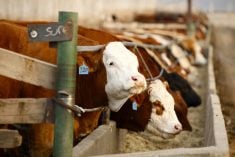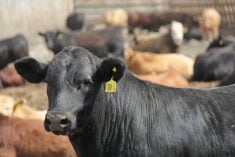Western Canadian feeder cattle prices experienced a mixed tone over the past week, with auction markets reporting prices $3 lower to $3 higher in comparison to seven days earlier.
The Prairie region continues to experience above-average temperatures causing significant deterioration to pasture and crops in Alberta and western Saskatchewan. Certain auction markets experienced slightly larger volume last week. Many feedlots have been caught off guard with the recent rally in barley and feed wheat causing feeding margins to narrow.
There is a fair amount of uncertainty moving forward, as the industry anticipates an earlier yearling run, and we may see larger volumes of lighter-weight feeder cattle come on stream over the next month. Southern Alberta experienced a larger run of light-weight heifers over the past couple weeks. Values for cow-calf pairs remain under pressure as hay prices continue to percolate higher. Fed cattle prices also have a softer tone, with Alberta packers well covered for their nearby two-week requirements. Year-to-date feeder cattle exports to the U.S. for the week ending June 6 were 213,789 head, down two per cent compared to last year.
Read Also

U.S. grains: Soy futures post biggest monthly gain in nearly five years on China trade optimism
U.S. soybean futures climbed to a 15-month high and posted their biggest monthly gain in nearly five years on Friday following a rally fueled by the prospect of revived exports to China.
A small string of mixed heifers averaging 731 pounds sold for $255 in east-central Alberta. In southern Alberta, mixed steers with no special feature averaging just under 750 lbs. sold for $277. Feedlots can realize positive margins on shorter-keep cattle, which appears to be supportive in the short term. Mixed heifers weighing 500 to 600 lbs. were selling in the range of $300 to $320 in southern Alberta.
The focus will remain on weather and extreme temperatures over the next month. Many feedlots were using feed wheat in the rations this past year but available supplies are dwindling. Feed barley stocks will be historically tight going into harvest but with the lower production, the market has potential to jump quite sharply in a short period of time. This is the largest risk influencing the feeder cattle market moving forward.
— Jerry Klassen is a commodity market analyst in Winnipeg and maintains an interest in the family feedlot in southern Alberta. He writes an in-depth biweekly commentary, Canadian Feedlot and Cattle Market Analysis, for feedlot operators in Canada. He can be reached by email at [email protected] for questions or comments.












